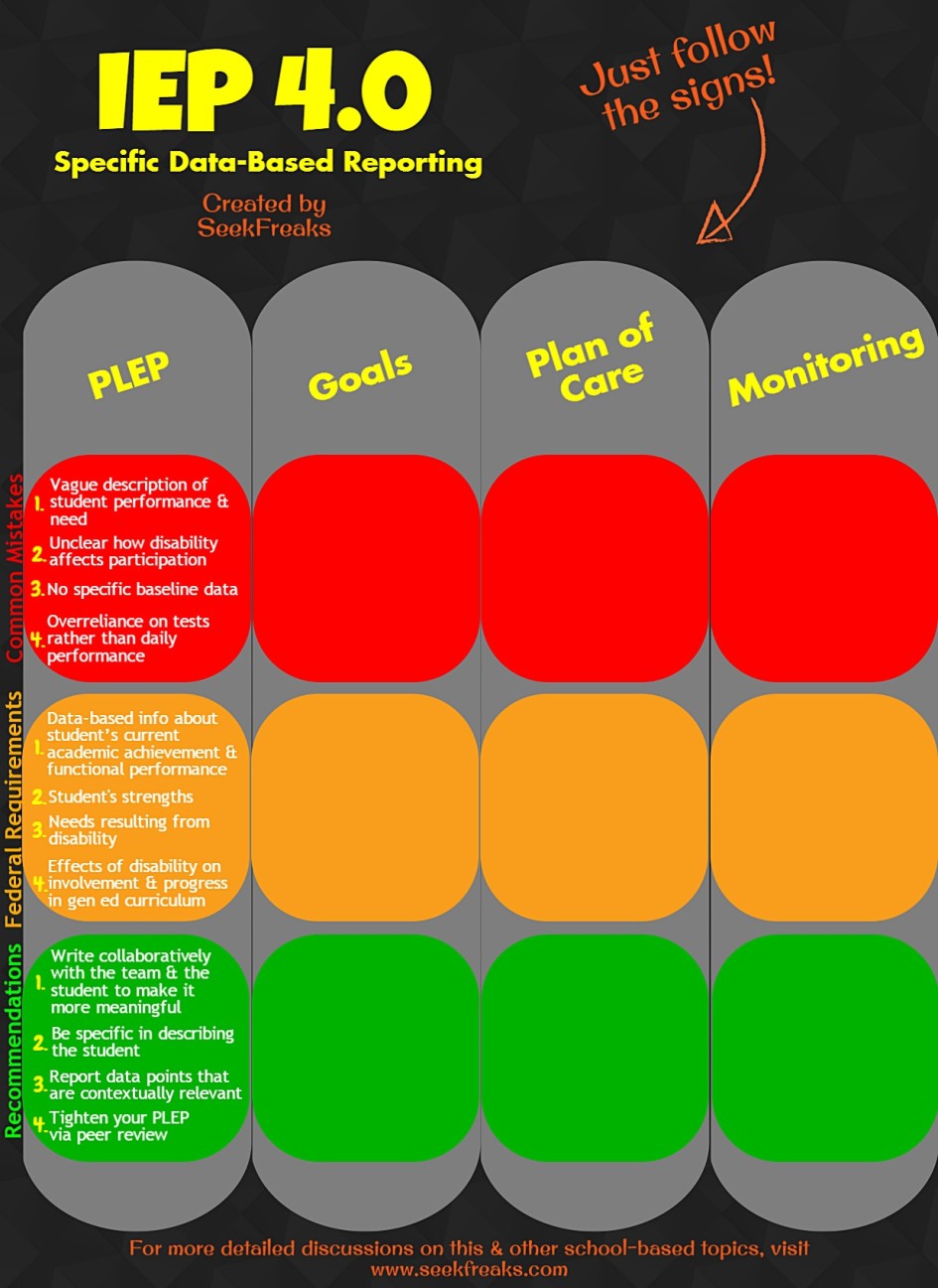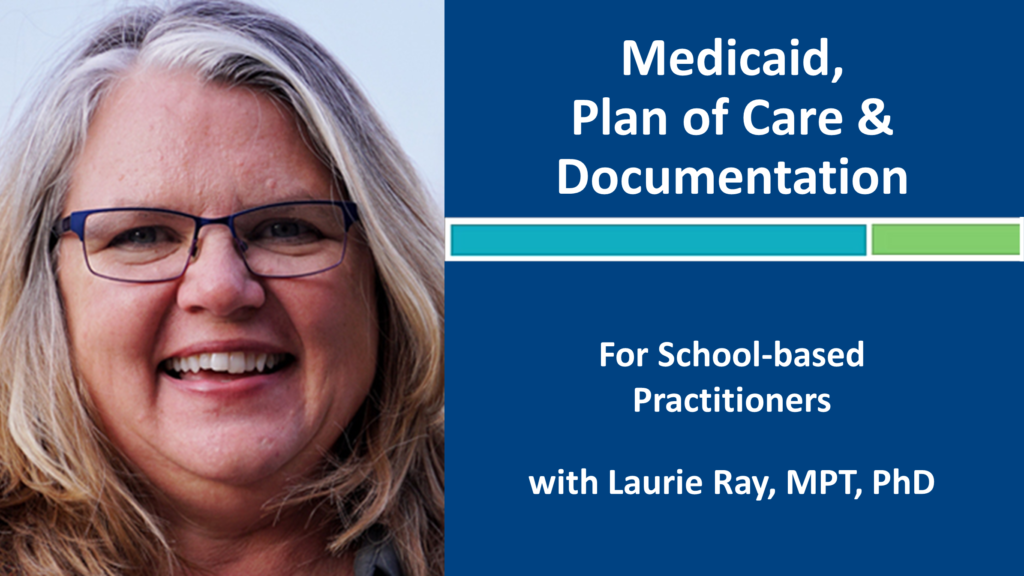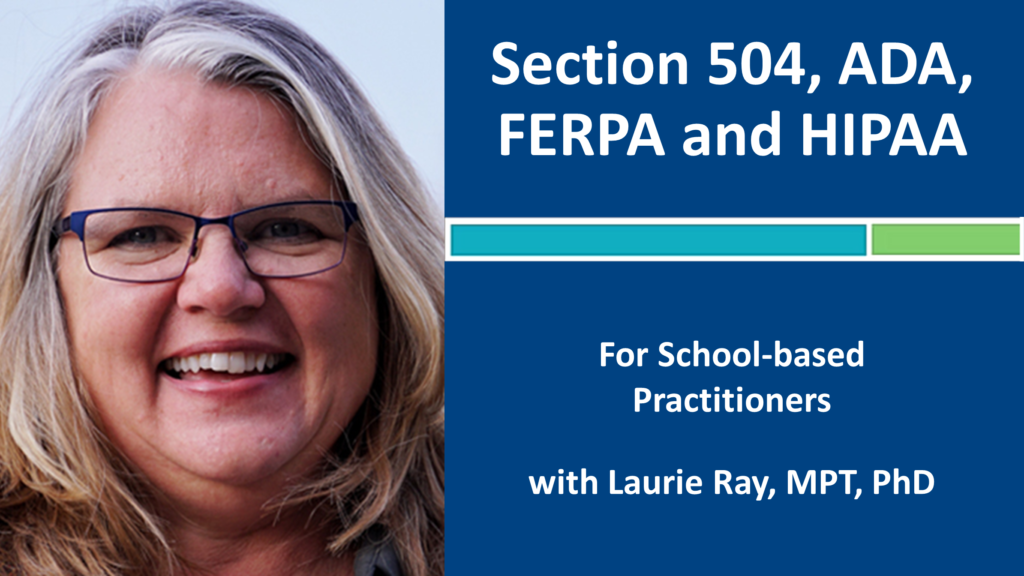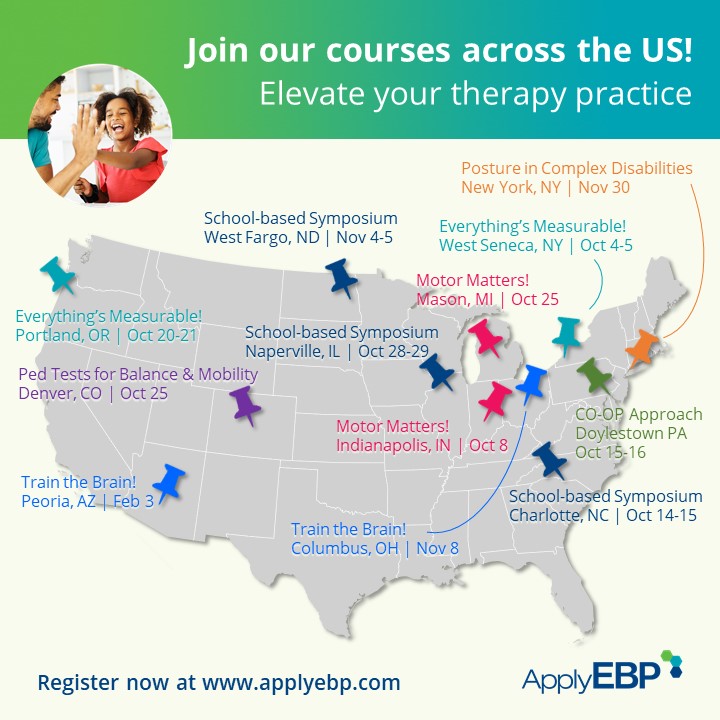Written by Laurie Ray, MPT, PhD, who has over 18 years of experience in school-based practice and is a state-level PT consultant for public schools. She also consults for Medicaid and Adapted Physical Education for her state and is an Associate Professor at UNC-Chapel Hill. Laurie also teaches continuing education via Apply EBP. More about these courses after the article below.
Note: This is a 4-part series on the IEP. You may jump to the other parts here:
- Part 2: Data-based and Student-focused Goals
- Part 3: Collaborative Progress Monitoring
- Part 4: Creating an Intentional Plan of Care
[smbtoolbar]
Present Levels of Academic and Functional Performance (PLAAFP), Present Levels of Performance (PLOP), Present Level of Educational Performance (PLEP), or whatever your district calls them, are the cornerstone of every IEP. As this part of the IEP sets the stage, we should give it our best. One of the first challenges is to identify appropriate domains or areas of need that the IEP must address. Some districts have requirements about domains. Domains can be curricula, such as language arts or healthful living. If your district does not have requirements; sometimes that is even more of a struggle to set the correct frame for the work of the IEP (e.g. peer play, mealtime, classroom behaviors, student judgement/safety).
Our work as school-based therapists is most effective when characterized by two approaches: collaboration with full IEP team (including students and parents in planning especially) and data-based decisions (using student performance data). These have been the aspects of IEP development that continue to improve student outcomes. All PLEPs should begin with the 3rd reporting period of any IEP. We should reach out to our IEP team to suggest our focus for the next IEP and begin to discuss potential goal areas. We should base all our efforts on student performance data or benchmarks that are established by peers.
Now changing any aspect of our work takes commitment, awareness and additional effort/planning time. We first have to be convinced that it is worth it! Here are some reasons I offer for your consideration:
- IDEA has increasingly focused regulations on increasing IEP team collaboration and parental involvement
- We know including students in the IEP development process and data collection changes the work and makes IEPs more meaningful. There is also evidence that including students in data collection and progress monitoring/reporting increases skill acquisition and decreases intervention time to attain goals (Hattie, 2011).
- Professionals who worked to rely on data and collaboration (integrating goals/embedding interventions) would not return to the approach that relies on solely his/her expertise and effort.
- It pinpoints student current performance and clarifies exactly what progress is required to attain grade level or age appropriate performance.
- When IEPs are collaborative and data-based, there is little need to promote ‘buy-in’ or motivate daily practice of skills by other school staff.
- Developing IEPs, PLEPs, student goals and progress monitoring plans becomes straight forward and simple, not an exercise in clairvoyance!
Okay, so what mistakes did I make that led me to this way of developing PLEPs?
- General vagueness about student performance and descriptions of need (Laurie needs to improve her ability to walk safely or Laurie needs to increase her ability to play with peers- what does improve mean? Doesn’t she need to play with peers, not just be able to do so?)
- Unclear descriptions on how the disability affects participation in and progress through the general education curriculum (Laurie struggles to access her campus or Laurie falls frequently- compared to whom?)
- Absence of specific baseline data in the PLEP and Annual Goal/s
- Overreliance on test scores rather than daily performance
How specific are we talking here? Very specific. While it is scary to be specific, we have to know where we are to get to where the student needs to be. Too often our IEPs are so unclear they mask student performance instead of identifying. We are uncomfortable with the bare truth but if student performance is unclear, we can spend years working on the same goals. Often students with complicated or severe disabilities require focused effort from all involved, from a variety of expertise to make any progress. Progress can be slow but we need to have an accurate starting point and sensitive measures to make a difference.
So what does this look like? Here are two examples:
Domain= Self care/Transition
Laurie is an 17-year-old with cerebral palsy that affects her arms and legs (spastic quadriplegic; GMFCS Level V). She has stiffness (extensor hypertonicity) in both her legs and arms (flexor hypertonicity), but her legs are stiffer. Laurie is well positioned in her personal power wheelchair (tilt-in space & postural supports), but doesn’t change positions much during the school day so we worry about her skin breaking down (skin integrity). She is independent with moving throughout her paved campus, can open doors and negotiate crowded hallways. She cannot go to the sports fields as they are inaccessible for her wheelchair. Laurie is dependent on others for and does not initiate/ participate in transfers. She needs moderate physical assistance with activities of daily living including 4-6 verbal cues from staff to adjust wheelchair to table/desk, hygiene (stand by assist with bilateral rails in modified stall and minimal assist doffing clothes/maximum assist with donning clothing) and eating (needs beverages held, stability at elbow and help to load spoon and conduct spoon to mouth). Laurie is very social (attends all dances and social events accessible with public transit) and intelligent; is a rabid ‘texter’. She expresses herself verbally with difficulty, mainly through gestures, facial expressions, saying and nodding “yes” or “no” and pointing with eyes and arms; uses computer/texting for most in depth interactions. Laurie lives with her grandmother who has great difficulty with transfers and struggles with pain. She and her grandmother rely on public transportation and always travel together. Laurie wants to go to college (will take the ACT in September). On the AIR Self-Determination Profile, Laurie is ~60% self-determined (score= 71). This test indicates her capacity for self-determination exceeds her opportunities to be self-determined both at school and home. She plans to take a one class at the community college next semester (need to work out transportation/do accessibility assessment). Laurie has a career goal to be computer programmer or web designer (on the Vocational Rehabilitation waiting list).
Now this is not a perfect example. We need to have more data on community college campus supports and vocational ability; but surprise= we are behind! In any case, use this PLEP to look for data that answers each of the federally required PLEP components below.
| Federally Required PLEP Components | Laurie’s PLEP |
| 1. Data-based information about the student’s current academic achievement and functional performance | |
| 2. Strengths of the student
|
|
| 3. Needs resulting from the disability
|
|
| 4. Effects of the disability on involvement & progress in the general education curriculum |
Can you see how strengths can be relevant to the student, not necessarily compared to peers? Is it easy to see where student goals are needed? What the criteria should be? Where interventions should take place? Can you see the data from various personnel and each disciplines’ role? Could you pinpoint levels of assist for various self-care requirements on a graph as a starting point? Could Laurie participate in data collection? Progress reporting to the IEP team?
Domain= Classroom behaviors/Transitions
Ralph is a 6 year-old boy in 1st grade. He has difficulty sitting on the floor independently for more than 2.5 minutes on average and wants to sit with his legs straight instead of criss-cross like his peers or leans on his arms or peers. Ralph can sit upright in his chair for 4 minutes and often leans on his desk/elbows. He stands and sits with poor posture (forward head, rounded shoulders, anterior pelvic tilt, locked knees, low muscle tone and noted joint hypermobility/laxity). Ralph attends to instruction for 3-4 minutes before exhibiting distracting behaviors or repetitive movements. He often lays his head on his desk, sings and talks with peers inappropriately. He can stand from the floor in 11.8 seconds on average (7.5 seconds on average for 5-6yo) and must use his arms. Ralph walks independently in the class, hallway and campus, although slower than peers transitioning between locations (from class to lunchroom/120’ = +2.8 minutes on average). He participates in PE small groups for 7.6 minutes (11.7 average for peers) before sitting down and struggles to participate. Ralph sits and/or talks and does not play or run during recess/free play. Ralph’s parents report having difficulty engaging him in physical activities and limiting his screen time.
Let’s try this again! Use the PLEP above to look for data that answers each of the federally required PLEP components below.
| Federally Required PLEP Components | Laurie’s PLEP |
| 1. Data-based information about the student’s current academic achievement and functional performance | |
| 2. Strengths of the student
|
|
| 3. Needs resulting from the disability
|
|
| 4. Effects of the disability on involvement & progress in the general education curriculum |
Are data points/benchmarks clear? Could you graph the starting point? Are these things important to a 1st grader? Contextually relevant? How could these skills be better integrated into daily routines?
Now get a PLEP you have written and identify the data that meets each component. Please comment on the post- what was different?
Also, consider a reasonable way to improve your PLEPs. Is there one IEP team that works really well, that is already collaborating? Can you try with the 3rd progress report to discuss the next IEP via email (make sure to include the parent…and student!)? or if not, can you bump up the specificity that you employ? Can you have a student performance data point for each statement?
All PLEPs can be improved. The BEST way to tighten up your PLEP is to use peer review. I hope you are convinced and challenged to find creative ways to collaborate with your team and increase your reliance on student performance data for your PLEP!!
Continue to IEP 4.0 – Developing Data-based and Student-Focused Goals
~~~~~~~~~~ 0 ~~~~~~~~~~
References and Resources
Capizzi, A. M. (2008). From assessment to annual goal: Engaging a decision-making process in writing measurable IEPs. Teaching Exceptional Children, 41(1), 18.
Drasgow, E., Yell, M. L., & Robinson, T. R. (2001). Developing legally correct and educationally appropriate IEPs. Remedial and Special Education, 22(6), 359-373.
Hattie, J., & Gan, M. (2011). Instruction based on feedback. Handbook of research on learning and instruction, 249-271.
Transition resources: http://transitionta.org/resources
Join author, Laurie Ray, and her colleagues in the following continuing education courses…
















March 29, 2016 at 4:59 pm
Laurie
I love this article and the measurable description! Just what I needed today!!
I agree that it is collaborative teaming that we all need. This involves student, parent, team members…The more we work together, the better the student “plan” becomes for the year.
March 29, 2016 at 11:35 pm
Excellent! So glad you found this helpful.
I find collaboration indispensable, especially with students who have complex &/or significant disabilities. Full team collaboration always makes the IEP better. Any effort to communicate is so worth it! A great investment.